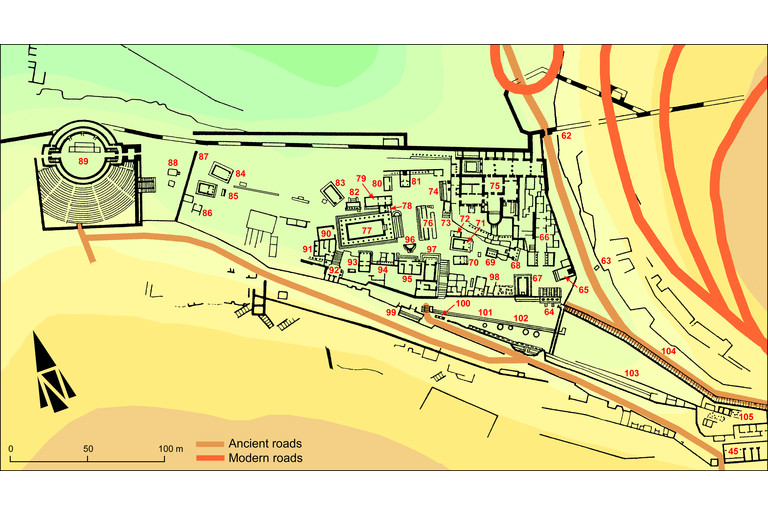Private honors
IGCyr016300
Trismegistos ID: 5998
Source Description
Support
White marble rectangular block with two holes for feet on the upper side, which was certainly adjacent to one or more other similar blocks, now lost, to form a large base (0.725; 0.305;0.60).
Layout
Inscribed on front face in two (or more) columns of two lines with a final line on the whole width of the original base.
Letters
0.025 at ll. 1-4; 0.035 at l. 5.
Place of Origin
Findspot.
Date
Probably second century B.C.
Findspot
Found in 1928 at Cyrene pleiades; HGL : Sanctuary of Apollo (see commentary).
Last recorded Location
Seen by C. Dobias-Lalou in 1983, placed on the unidentified temple W of the Temple of Artemis .
Text constituted from
Transcription from stone (CDL).
Bibliography
Oliverio, 1930 Oliverio, G., 1930, Campagna di scavi a Cirene nell’estate del 1928, Africa Italiana3, 141-229 - see in bibliography , p. 190, n. 14, whence SEG Supplementum Epigraphicum Graecum, Leiden, then Amsterdam, 1923-1971, then 1979- - see in bibliography , 9.67.
Apparatus
(For Oliverio's layout, see commentary)
5 Ἀκε[---] : Oliverio, 1930 Oliverio, G., 1930, Campagna di scavi a Cirene nell’estate del 1928, Africa Italiana3, 141-229 - see in bibliography Ἀκέ[στα?] || [ἀνέθηκε] : Oliverio, 1930 Oliverio, G., 1930, Campagna di scavi a Cirene nell’estate del 1928, Africa Italiana3, 141-229 - see in bibliography [---]
French translation
Phainippos fils d'Akestas.
[Un tel fils d'Un tel].
Akeusilea fille d'Ake[---] [ a consacré] (les statues).
English translation
Phainippos son of Akestas.
[So-and-so son of So-and-so].
Akeusilea daughter of Ake[---] [ dedicated] (the statues).
Italian translation
Phainippos figlio di Akestas.
[Il tale figlio del tale].
Akeusilea figlia di Ake[---] [ha dedicato] (le statue).
Commentary
Oliverio published the stone as found N-W of the Roman Propylaeum, but it should be an error, because an ancient photograph (Department Archive D.501) shows the stone at the very place where it was still in 1983, with view on the Greek theatre, as if Nikodamos' Wall was not yet unearthed.
Oliverio did not introduce a hierarchy between the preserved names, because he did not notice the different heights of the letters nor the different placement of l. 5 vs. ll. 1-4. He did not thus suspect the layout of the latter in columns.
At l. 5, Oliverio restored the father's name as Akestas and thought this woman to be the sister of Phainippos. However, a name in Ἀκευσι- would also be possible. The feminine name Akeusilea has now another occurrence at Cyrene (see IGCyr121100).
Creative Commons Attributions-NonCommercial 4.0 International License.
All citation, reuse or distribution of this work must contain a link back to DOI: http://doi.org/10.6092/UNIBO/IGCYRGVCYR and the filename (IGCyr000000 or GVCyr000), as well as the year of consultation.
